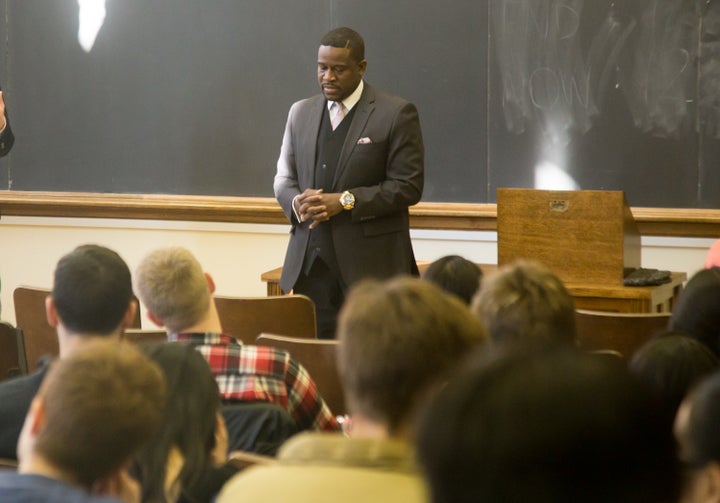Since the controversial shooting of Michael Brown on August 9, 2014, in Ferguson, Missouri, a national debate on police, race, social status and ethnicity has become the new norm of America. Unlike the initial criminal justice reform debates that were fueled by over one hundred days of continual public protest that eventually erupted into riots and looting in Ferguson, the continued wave of unrest still emanating from Urban America has begun to spark calls for aggressive legislative reforms for improving police initial contact with citizens from multi-ethic communities. In addition, court-enforceable consent decrees have been issued by the Department of Justice to institute police reforms in departments that have found themselves lacking a fortified Urban Portfolio after a catastrophic incident between police and multi-ethic communities.
Change Comes From the Top
The first step to improving police community relations is for law enforcement agency administrators, law enforcement executives and command staff to take responsibility to effectively and properly educate their officers and agents about why segments of the population distrust police and other law enforcement officials. Furthermore, law enforcement agencies cannot become obsessed with trying to critique the legitimacy of social movements such as Black Lives Matters, which has become its own lightening rod among police and law enforcement culture. As a 21 year police veteran and now police commander, in the past three years I have sat down with Police Executive Research Forum officials, Federal Bureau of Investigation officials, Justice Department officials, Mayors, Congressmen, Senators, National Fraternal Order of Police leaders, National Association for the Advancement of Colored People, the National Association of Black Law Enforcement Officers, the National Organization of Black Law Enforcement Executives, and others who all are struggling to draft solutions that would attempt to calm the current racial climate between police and communities of color. Most all of, the dialogues have concluded that at this current stage of police and race relations many more challenges exist than initially thought.
Often, many law enforcement administrators will act on their first respondent’s instincts and feverishly search for a quick fix solution to “make it all go away.” Other immediate strategies often have included taking a closer look at minority hiring of candidates and the swift promotion of minority officers (for positions that were historically held by non-minority officers) as a neutralizer to community unrest. The most impulsive reaction by departments is often to implement training on cultural sensitivity and bias reduction. Though all of these actions could potentially yield results, it is imperative that present day and especially future law enforcement agency administrators and command staff weigh their urgency to commit to a continued process of change and agency improvement. The most consistent and historical approach used nationwide has been a police department’s ability to maintain an open dialogue with clergy leaders in the African American churches. This by far will always be an effective fail-safe tool in building and protecting ongoing relationships with the Black community. However, in our current day not all Black people are Christian and not all Black people attend church. Therefore, departments must expand their partnership circle to include Muslims Imams, Nation of Islam Ministers, Black Lives Matter representatives, and representatives from LGBTQ organizations.
Many police officers and community members agree that the time to talk about race relations, social status, religion, and gender orientation has been long overdue. The challenge in addressing race relations in America between the urban community and the police has always been about creating a “safe space to talk race.” Law enforcement agency administrators, law enforcement executives and command staff create innovative post incident command cultural preparedness strategies backed by training and new policies that protect their department’s “Urban Portfolio” of police and community relationships from being destroyed by local and national catastrophic incidents between police and the urban community.
….The shooting of unarmed, Walter Scott on April 4, 2015, in North Charleston, South Carolina, following a daytime traffic stop for a non-functioning brake light. Scott, a black man, was fatally shot eight times in the back by a white North Charleston police officer. In addition, the shooting of Walter Scott may go down as being one of the most provocative incidents that threatens the stability of American law enforcement and its ability to effectively police black Americans.
After such an incident, l law enforcement agency administrators, law enforcement executives and command staff should mobilize community leaders, clergy, activists, select elected officials, youth representatives, and local media to have intimate dialogue about the incident behind closed doors in efforts to preserve the achievements gained through their previous positive police social interactions. In most times of crisis, each department should have one or two community negotiators. These should not be confused with hostage negotiators. Community negotiators are the few officers or command staff that have such a great rapport with the particular community in crisis. Moreover, these select group of officers would likely be more than comfortable in engaging in heated discussions needed for the purpose of racial and cultural de-escalation.
Such community crisis engagement tactics and approaches unofficially exist in many departments and law enforcement agencies. However, they are not a part of the agency’s strategic plan and may not exist within their training divisions. Here is where the hardcore conversation begins. It is imperative that law enforcement agency administrators, law enforcement executives and command staff develop biannual in-service “Tabletop” training programs specifically directed at improving community engagement, and developing a skillset for racial and cultural de-escalation. In addition, new recruits and cadets must enter their academy training with an elaborate community engagement curriculum that will prepare them to be their departments’ front-line community negotiators equipped with skillsets in racial and cultural de-escalation and social program outreach. Workshops and curriculums for these skills must greatly exceed Peace Officers Standards and Training Council (POST) standards and should take on an innovative “out of the box approach.”
Scientific Approaches
When asked about the best scientific approach? The response is often, “find the best practice.” From the current state of police and urban relations nationwide, previous alleged best practices regarding effective community policing have not improved the historically poor relationship between police and the urban community particularly when engaging Black, Hispanic and Latino males. Most POST standards only require new recruits and cadets to do four to eight hours of social programming over six months of training. Many police and law enforcement agencies grossly lack diversity within their academy classes, training staff, command staff and executive leadership. This further exacerbates stereotyping and biases of race, culture, social status, gender and religion due to the department’s culture of a direct lack of knowledge. This creates the “us against them syndrome” in law enforcement.

Shafiq R. F. Abdussabur guest lecturer Yale University Divinity School “Black, American, Muslim, and Cop”
Getting Started
Moving an agency towards effective police social interactions begins with the agency’s commitment to “do better by its communities of color.” Mission statements must be reviewed and modified. Training instructors and command staff must be reflective of both the community that the department serve and the content of the material being represented. Community partners and urban leaders cannot be called only during a crisis. Every police department and law enforcement agency in America should a strategic plan no less than five years in duration. The strategic plan should address challenges, community engagement, policy updates, operational standards, promotion, inclusion, diversity, wages, and non-arrest proactive policing methods. In addition, a purposeful and intellectual discussion must be developed and expanded to include meaningful discussion with the American Muslim community, grassroots social movements, and the LGBTQ communities. In order to effectively embark upon that journey and be successful, police departments and law enforcement agencies will need to train their officers and agents to be their own first responders in addressing issues on race, social status, religion, ethnicity, and gender within the communities they are sworn to protect and now challenged to serve.
